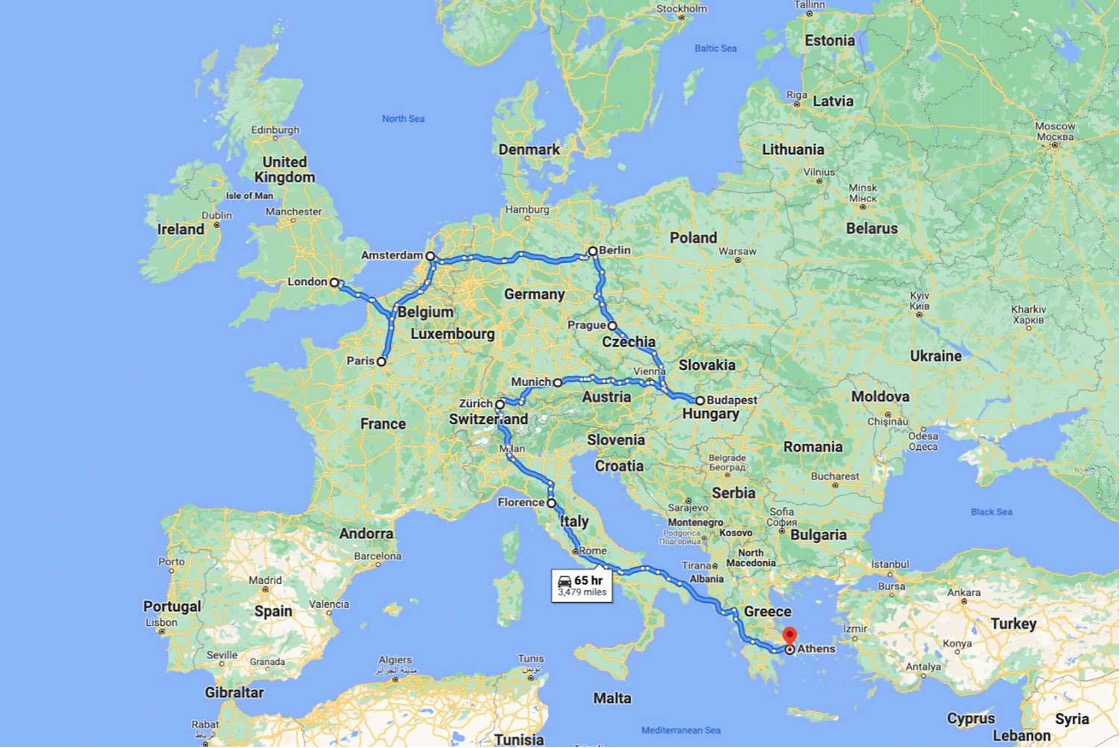Here are some tips for your first trip to Europe.

Whether you study abroad, backpack solo, or go with a group for your first trip to Europe, it’s an experience that will change your life—in a good way!—forever. Even if you visited the continent with your parents as a kid, your first “solo” adventure will feel fresh and new. Read on for tips for planning your first trip to Europe like a pro.
Get around with a Eurail Pass.
Do you need a Eurail pass to get around Europe? Maybe not, but I recommend it, especially if you are younger than 28. Most of Europe is well-connected via a vast rail network spanning the continent. A Eurail pass—available exclusively to non-Europeans—makes it hassle-free to hop among countries and even ride regional trains. Depending on your travel plans, you can purchase passes for specific countries or regions and choose whether you need unlimited travel or a set number of travel days. Remember once you’re in Europe, hops between major cities are often surprisingly low-price (I’ve seen flights for as little as $6), but often a train is the best choice when you factor in time, convenience, price, and the chance to watch the world go by from your window. Splurge on first-class passes, and you’ll always have a comfortable seat.
Plan your trip geographically.
Make a list of all your must-hit places, then look at where they fall on a map, connect the dots, and you will have your route. Maybe you start in Spain and work your way east, or fly into London, take the Chunnel to Paris, and work your way down to Italy. Whatever you choose, ensure your route makes sense geographically so you don’t waste time (or money) crisscrossing the continent.
Keep seasons in mind.
Europe is a large continent that includes a variety of climates. It may seem obvious, but if you’re planning a summer trip, don’t expect to frolic in fields of Dutch tulips (that happens in the spring) or ski the Austrian slopes (that would be a winter thing). And as enchanting as the European Christmas markets look on Instagram, don’t be disappointed when you put two and two together and realize they’ll only make it to your feed if you’re going to Europe in November or December. An Italian summer is nothing short of sweltering and ice-cold AC isn’t a given, so you may want to rethink covering all of Rome on foot at high noon in August. (A midday siesta is common in countries like Spain and Italy for a reason, so do as the locals do and take the summer weather into account before you overexert yourself.)
Book in advance.
You don’t have to have your entire trip planned out before leaving home. (My Type-A cousin had a down-to-the-minute itinerary mapped out for her and her Type-B husband on their first venture to Europe, and he almost left her as she dragged him from museum to walking tour to restaurant reservation and so on.) Part of the fun—especially if you have a Eurail pass—is going where the wind blows you and deciding what appeals to you upon arrival. Pro tip: Taking a bus tour on your first day at a destination is a great way to get the lay of the land and cover a lot of ground quickly (without exhausting yourself). Make a general timeline and book your departure flight from the USA to Europe before you leave home, but perhaps wait until you’ve hopped the pond to book your flight back. You may decide to stay longer in a particular country or run out of time to make it all the way to Portugal, where you originally intended to fly home from. Create a general outline, but leave some of your trip open and stay flexible. The one thing you may want to do in advance is reserve hotels, hostels, and Airbnbs because they can fill up during the popular summer months. That’s why it’s helpful to have a general idea of where you’ll be and when; just don’t cling to your plan at the expense of a spontaneous sidetrack or two.
Here’s what to bring.
Start working on your packing list a few months beforehand. What you bring will vary depending on destinations, length of trip, and your fussiness level, but there are a few non-negotiables. Don’t leave home without:
-Your passport
-Converters for European outlets (UK and/or EU, as needed)
-A credit card and/or a debit card for getting cash out of an ATM (you’ll get a better rate doing it this way than through a currency-exchange counter)
-COVID-era items such as your vaccine card, printed copies of your negative COVID test results (if required), and a few self-test kits
-A secure envelope to hold all of these important documents (including a few color copies of your passport) in one place
-An eSim app or an international plan added to your phone (unless you’re a T-Mobile customer)
You’ll also find life to be a lot easier with a translation app and currency conversion app on your phone. Before you depart, download the countries you’ll be visiting to ensure offline availability. And pack light: You really will need nothing more than a backpack/tote and a carry-on, max. Trust me. (There are laundry rooms at hotels/hostels and laundromats in every city.)
Here’s where to go.
If you only have time or the budget to see a few places, start with the basics. You’ve likely heard/read /seen photos and films about major cities like London, Paris, and Rome since you can remember; now’s the time to check them out through your own eyes. Once you have the must-hit places on your itinerary, plan some additional stops according to your interests. There’s a lot for first-timers to see in Italy outside of Rome—think about Venice, Cinque Terre or the Amalfi Coast, Florence, and the Tuscan wine country. Maybe you’ve been researching your ancestry and discovered you have Hungarian heritage; add Budapest to the list. Or perhaps you’ve always dreamed of hiking the Swiss Alps, clinking glasses in a German beer hall, or soaking up the sun in the Greek Isles. Maybe you want to visit Poland and pay your respects at Auschwitz or try every waffle you come across in Belgium. You can do it all if you have enough time, but start by arranging a shortlist with your top priorities and then tack on additional destinations based on your interests, priorities, and goals. If you’re purely on “vacation” with no remote work or school obligations, two to three days in each place should suffice, but if you can’t devote your full attention each day to exploring, then you’ll want a little extra time in each city to do it justice.
Twist’s Take: Check out these tips for your first trip to Europe.

